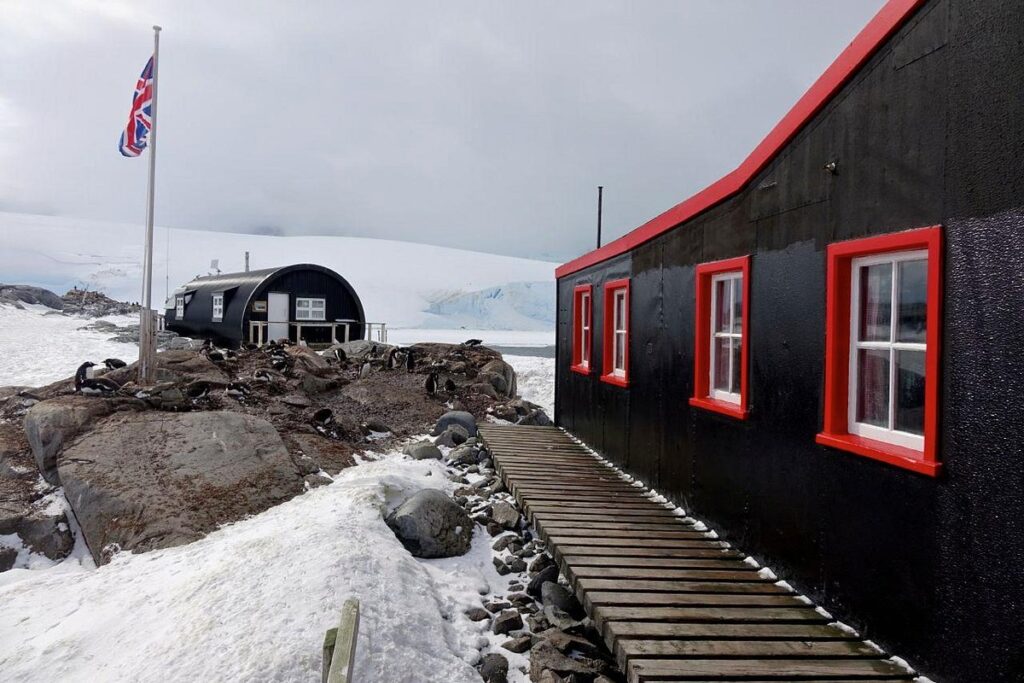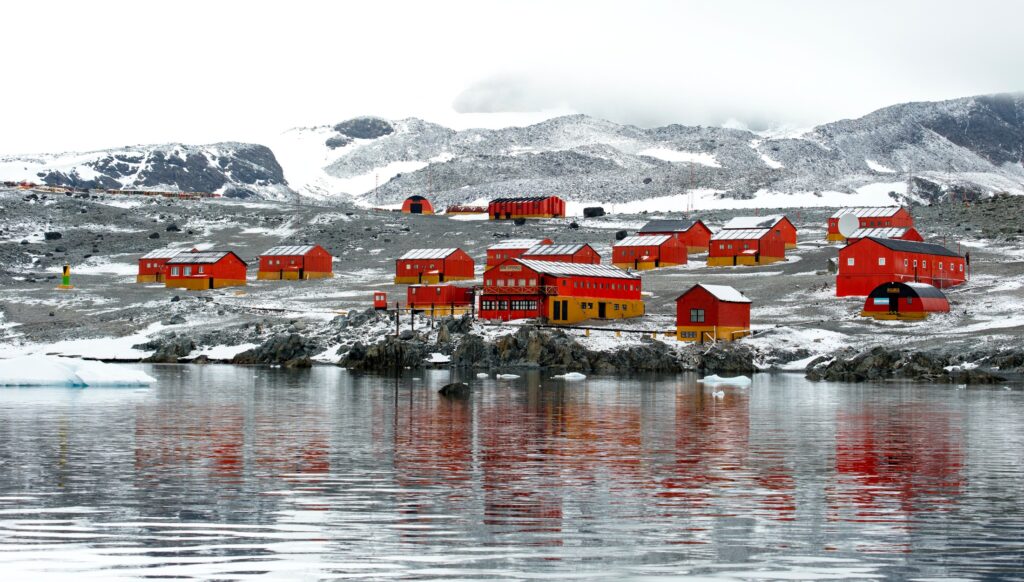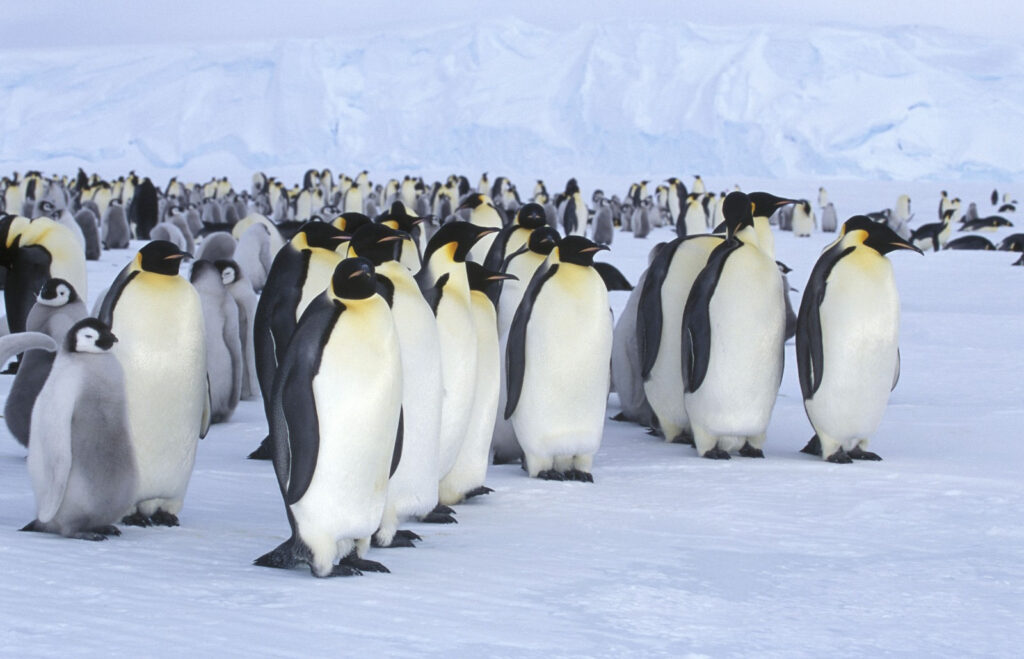The Antarctic Peninsula, the most accessible region of the continent, stretches northward toward South America’s Tierra del Fuego, as if inviting explorers with open arms. This stunning area, often humorously dubbed the ‘Banana Belt’ due to its relatively mild climate, is the warmest part of Antarctica and serves as a vital breeding ground for seabirds, seals, and penguins—drawing adventurous travelers from around the world.

This dramatic, narrow channel—just 1600 meters (5250 feet) wide—stretches for 11 kilometers (7 miles) between the towering mountains of Booth Island and the Antarctic Peninsula. So striking in its scenery, it has earned the nickname ‘Kodak Gap,’ though it remains hidden from view until vessels are nearly within it. First navigated in 1898 by Belgian explorer Adrien de Gerlache, the channel was named in honor of a fellow Belgian who explored the Congo.
However, heavy ice can sometimes block the passage, forcing ships to turn back and navigate around Booth Island. At the northern entrance of the Lemaire Channel stand two tall, rounded, often snow-capped peaks that mark Cape Renard.

In 1996, Britain beautifully restored Bransfield House, the original station building and main hub of Base A. Now a museum, it showcases the station’s rich history with displays and intriguing artifacts—like clothing from Operation Tabarin, a secret 1944 radio transmitter, a vintage wind-up HMV gramophone with Noel Coward records, and a pair of wooden skis bought in 1957 from the Grytviken Whaling Station Stores on South Georgia. One scientific gem on display is the restored ‘Beastie,’ an early device used for upper-atmospheric research.
A quirky highlight not to be missed is the full-length portrait of Marilyn Monroe, painted on the back of the generator-shed (now gift shop) door—originally created as a morale booster for lonely male researchers during Antarctica’s early all-male days.
Each summer, three UK Antarctic Heritage Trust (UKAHT) staff members live at Port Lockroy to care for the historic site. They also operate a bustling post office—hand-stamping about 70,000 mail items annually—and manage a well-stocked souvenir shop. Proceeds from the shop support museum operations and fund the preservation of other British historic sites across the Peninsula. They accept US dollars, and if needed, British pounds and euros, though Visa and MasterCard are preferred (no American Express).
To ensure sustainability, visitor access is limited: no more than 350 people per day, with just 60 allowed ashore at any one time. Since the base doubles as the staff’s summer residence, visitors are kindly asked to respect their private areas.

Established in 1968 on the southwest coast of Anvers Island, Palmer Station was named in honor of American sealer Nathaniel B. Palmer, one of the first to sight Antarctica in 1820. It replaced the earlier ‘Old Palmer,’ a cluster of prefabricated wooden huts set up in 1964 about a kilometer across Arthur Harbor, which itself succeeded Britain’s Base N, occupied between 1955 and 1958 and now no longer standing.
Today, Palmer Station accommodates up to 44 people during the summer season, while around 25 remain through the winter. Open to sea access all year, the station receives supplies approximately every six weeks via ship.
Palmer consists of two main buildings—the three-story BioLab and the two-story GWR building (Garage, Warehouse, and Recreation)—along with additional facilities such as a boathouse, dive locker, clean-air lab, sauna, workshops, and storage buildings, all clustered closely together. The BioLab houses laboratories, dining and sleeping areas, offices, and communication rooms, while the GWR includes sleeping quarters, generators, a small medical clinic, and the station store.
Research at Palmer is centered around long-term studies of the marine ecosystem—especially seabirds and krill—alongside atmospheric monitoring and investigations into the effects of ultraviolet radiation and climate change on both marine and terrestrial environments.
To minimize disruptions, only 12 ship visits are allowed each year. Tourists are treated to a guided walking tour, which includes a look at two aquariums featuring local marine life like anemones, mollusks, krill, sea urchins, and fish. Visitors can also shop at the station store (which accepts US dollars and credit cards) and try the famously delicious ‘Palmer brownies’ in the dining hall.
Among the station’s charming quirks are the large orca mural painted on the fuel tank—sometimes used as an outdoor movie screen—and a metal krill-shaped weather vane perched on top of the sauna.

The black-walled hut from the Swedish South Polar Expedition is the oldest surviving structure on the Antarctic Peninsula and is now a protected historic site. Originally prefabricated, the hut became home to five Swedish and one Argentine scientist who endured an unexpected two-year stay. Perched on a delicate beach terrace prone to erosion, it is carefully preserved and access is limited to prevent damage.
Measuring 6 by 8 meters, the hut features three double bunks, a small kitchen, and a central living space. Two angled wooden planks, part of the original design, still support its northeast wall. Inside, visitors can find English-language leaflets detailing the hut’s history, while two large signs outside, written in Spanish, offer additional context.
The site is maintained by the Argentine government, whose Marambio Station lies 21 kilometers northeast on Seymour Island. To protect the structure, no more than five people may enter the hut at a time, and visits are not allowed between 7 p.m. and 8 a.m.
Just behind the hut lies a snow-free ravine where visitors can discover fossils of clams and ammonites scattered in the gravel—perfect for examination and sharing, though collecting them is strictly prohibited.

Established as a naval post in 1930 and officially opened as a base in 1951, Argentina’s Esperanza Station was significantly expanded in 1978 to support year-round family living—part of the country’s strategic move to assert sovereignty over Antarctic territory.
That same year, a remarkable event took place: Silvia Morello de Palma, the pregnant wife of station leader Captain Jorge de Palma, was flown in from Argentina at seven months pregnant. On January 7, 1978, she gave birth to Emilio Marcos de Palma, the first person born on the Antarctic continent. Over the next five years, the station welcomed seven more births—four boys and three girls.
Today, Esperanza is home to around 20 children and their families, with the station capable of accommodating up to 100 people. About 35% of the population consists of spouses and children, while most of the staff are military personnel. The station resembles a small village more than a traditional research base, featuring 13 family chalets, a chapel, a bank, a post office, an infirmary, a gravel soccer field, a graveyard, and 1.5 kilometers of gravel roads. Only two small labs are used for scientific work.
Near the jetty, visitors can see the remains of a stone hut where three members of the 1903 Swedish Antarctic expedition led by Nils Otto Gustav Nordenskjöld survived a brutal winter, living off seal meat. The bay is named in their honor. Reconstructed in 1966–67, the hut stands as a testament to early polar exploration, and a small museum inside one of the station’s buildings preserves related relics. Additional historic artifacts are displayed outside near the original site.
A nearby ice runway on the Buenos Aires Glacier supports occasional air traffic, with DHC-6 Twin Otters flying in from Marambio Station approximately 20 times a year.

Established in 1975, the UK’s Rothera Research Station sits on a small peninsula along the southeast coast of Adelaide Island. In 1990–91, the addition of a 900-meter gravel airstrip and hangar transformed Rothera into a key logistics hub for British operations across Antarctica, supporting Twin Otter aircraft. A 60-meter dock, Biscoe Wharf, also completed during the same period, enables regular ship-based resupply missions. The station can host up to 130 people during the summer season, with an average of 21 overwintering.
Rothera Point, where the station is located, was named in honor of John Rothera, a British surveyor active in the region during the 1950s.
At the heart of the station is Bransfield House, which houses the dining area, bar, library, offices, laboratories, and an elevated operations control tower. The station’s two dormitory buildings commemorate the final sledge dog teams once based at Rothera. Admirals House, opened in 2001, offers en suite rooms for two, while Giants House, built in 1997, features shared four-person rooms with communal bathrooms.
The Bonner Laboratory—named after renowned polar biologist Nigel Bonner—was initially completed in 1997 but suffered a major setback when a fire caused by an electrical fault destroyed it in September 2001. Rebuilt at a cost of £3 million, it reopened in January 2004. The state-of-the-art facility includes a cold-water aquarium and an emergency compression chamber for diving incidents. Researchers at the lab have observed alarming environmental impacts—just a 2°C increase in water temperature has left some marine species defenseless against predators, highlighting the delicate balance of the Antarctic ecosystem.

The Ukrainian Vernadsky Research Base, located on Galindez Island, accommodates up to 24 people and has a colorful history. Originally established by the British and known as Faraday Station—named after the pioneering scientist Michael Faraday—it was sold to Ukraine in 1996 for the symbolic sum of £1. Visitors can spot the actual £1 coin embedded in the wooden panel between the taps at the station’s bar, a nod to this unique transaction. The station was renamed in honor of Vladimir Vernadsky, the first president of the Ukrainian Academy of Sciences.
One of the station’s best-loved features is its cozy pub, a relic from British times. It boasts a dartboard, billiards table, and an ornately carved wooden bar—crafted by carpenters who, legend has it, were meant to be doing something entirely different. The pub walls are covered with flags, banners, and photographs left by visiting ships and research teams. Perhaps its quirkiest tradition is a growing collection of bras, contributed over the years by adventurous visitors. Guests are encouraged to try the station’s fiery homemade pepper vodka, known as gorilka—just say “Budmo!” and down the shot like a local.
The station store offers a unique range of souvenirs, including a bottle of “low-ozone air” harvested on-site and labeled for curious collectors.
After acquiring the base, one of the first improvements made by the Ukrainian team was the addition of a sauna, a welcome touch in Antarctica’s cold climate.
Importantly, Vernadsky continues to play a role in environmental research. Long-term data from the base reveals that since 1947, the average annual temperature along the Peninsula’s west coast has risen by about 2.5°C. This warming trend has led to reduced ice coverage and a notable increase in local vegetation such as Antarctic hairgrass and pearlwort—clear signs of a changing climate in one of the world’s most fragile ecosystems.

Located on the fast ice roughly 400 meters off the low ice cliffs of Snow Hill Island’s south coast, this is Antarctica’s northernmost and most accessible emperor penguin rookery. It was first spotted from the air in 1997, but only in 2004 was it finally reached—by a Russian icebreaker carrying adventurous tourists.
The colony is home to over 4000 breeding pairs of emperor penguins, offering a rare and remarkable opportunity to observe these majestic birds up close in their natural habitat. Their presence so far north is especially notable, as emperor penguins typically breed farther inland under much harsher conditions.
Access to the site, though still dependent on ice and weather conditions, has made Snow Hill a coveted destination for both scientists and wildlife enthusiasts eager to witness the remarkable life cycle of these iconic Antarctic inhabitants.
WhatsApp us